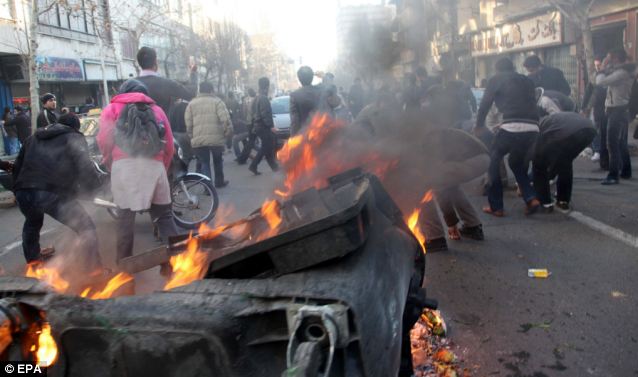Amidst a torrent of cries across the Middle East for an end to corruption and dictatorship, uprisings in the Islamic Republic of Iran which began on Valentine’s day have been met with tear gas and paintball bullets, Al Jazeera reports.
In the capital city of Tehran, the Guardian reported the presence of several thousand protesters on Enghelab and Azadi streets in the city center on Feb. 14. Some twenty to thirty thousand others have made their voices heard in cities across Iran.
The uprisings are part of a wildfire of civilian demonstrations against accused political abuses. In the mix with Iran have been Egypt, Libya, Yemen, and Bahrain.
However, under President Mahmoud Ahmedinejad and spiritual leader Ayatollah Ali Khameini, Iran’s leadership has cracked down on the opposition with an iron fist.
The protests are the first to shake Iran since demonstrations over the allegedly rigged results of the 2009 presidential elections, which saw the loss of opposition leader Mir Hossein Mousavi to Ahmedinejad. Since then, tensions have slowly simmered over this incident, along with a litany of alleged human rights abuses and economic issues affecting the nation.
“Mubarak, Ben Ali, now it’s time for Sayyid Ali,” cried Iranian demonstrators in Youtube videos posted by protesters, referring to Ayatollah Khameini.
“Political prisoners must be freed,” chants a woman in a Youtube video reported to be taken at the protests on Feb. 14.
One person has been killed and dozens more hospitalized with severe injuries, according to an AP Newswire. Faced with violent suppression, many protesters have tried to disperse the demonstrations over a wide number of locations according to The New York Times. Such measures were taken to diminish the police presence at any given location.
The Times reports that the government attempted to shut down cell phone service and bring the speed of online connectivity to a grinding halt. In spite of this, large numbers of civilians were able to access twitter feeds indicating the times and locations of demonstrations.
The Iranian government has not only responded with violence, but also with alleged propaganda intended to defame the legitimacy of the uprisings.
“The protests have been ignited by Western spies,” said Brig. Gen. Mohammad Reza Naghdi of the protests to the government-controlled Fars News Agency. “Western intelligence agencies are searching for a mentally challenged person who can set himself on fire in Tehran to trigger developments like those in Egypt and Tunisia.”
Reflecting the spirit of the movement, opposition spokespersons Mehdi Karoubi and Mousavi called for solidarity with the demonstrations in Egypt and Tunisia, and even joined in the rallies themselves.
In response, the Iranian government has shut down the website of Mousavi and Karoubi, as well as blocked access to their houses.
In the face of this hostility, many Iranians retain a sense of optimism for things to come.
“What I saw in the streets today was very promising-it showed that the movement is quite alive in spite of all crackdowns and arrests and people are still striving for freedom,” said an Iranian student who refused to be identified to the Guardian.
The international response to the demonstrations has largely been of one of shock and outrage at the Republic’s harsh treatment of activists.
“Iranians have a right to gather to peacefully express their support for the people of Egypt and Tunisia” said Mideast Deputy Director of Amnesty International Hassiba Hadj-Sahraoui to Al Jazeera. “While the authorities have a responsibility to maintain public order, this should be no excuse to ban and disperse protests by those who choose to exercise that right”

